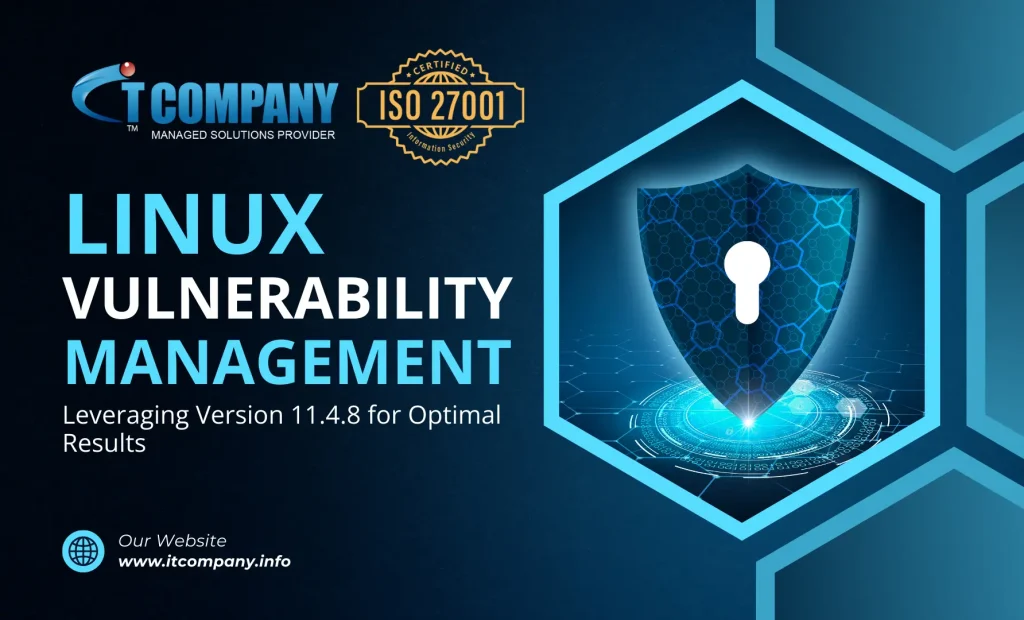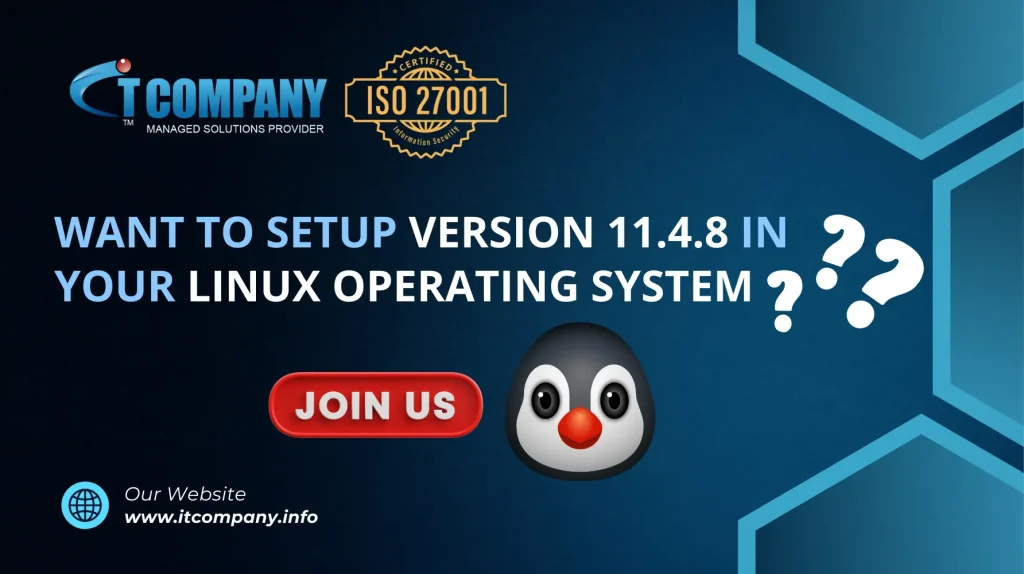
Version 11.4.8 is a powerful tool for managing Linux vulnerabilities and operating systems. Even with its advanced capabilities, outdated software and misconfigurations, you can still put your data at risk and hack your website.
To ensure your critical data is protected, partner with an IT company offering ISO 27001 certified Linux services. Their expertise will effectively manage and resolve these issues, keeping your systems secure from potential threats.
Table of Contents
ToggleWhat is 11.4.8 scan for Linux Vulnerabilities
Version 11.4.8 is a sophisticated software tool designed to enhance the security of Linux operating systems. It provides comprehensive features for identifying and managing security risks, for example, outdated software and misconfigurations.
Key features include advanced vulnerability scanning, automated patch management, detailed reporting and analysis, a user-friendly interface, and seamless integration with other security tools.
Problem Identification
Below is a table that breaks down common vulnerability challenges in Linux and the potential impacts of ineffective vulnerability management:
| Common Vulnerability Challenges in Linux | Description | Impact of Ineffective Vulnerability Management |
| Outdated Patches | Software and system components that haven’t been updated with the latest security patches. | Security Breaches: Exploits can target known vulnerabilities, leading to unauthorized access. Data Loss: Critical data may be compromised or stolen. System Downtime: Exploits can cause system crashes or disruptions. |
| Misconfigurations | Incorrect or insecure settings in system configurations, such as file permissions or user access controls. | Security Breaches: Attackers may exploit misconfigured settings to gain unauthorized access. Data Exposure: Sensitive information may be exposed to unauthorized users. Compliance Issues: Non-compliance with security standards can result in regulatory penalties. |
| Unpatched Vulnerabilities | Known security flaws in software or hardware that have not been patched. | Security Breaches: Unpatched vulnerabilities can be exploited by attackers to gain control of systems. Data Loss: Unpatched issues can lead to data theft or corruption. System Compromise: Attackers can use unpatched cloud vulnerabilities to compromise and disrupt system operations. |
| Weak Authentication Mechanisms | Insufficient security measures for verifying user identities, such as weak passwords or lack of multi-factor authentication. | Unauthorized Access: Weak authentication can allow unauthorized users to access sensitive data. Account Hijacking: Attackers may take over user accounts, leading to misuse or data breaches. Increased Risk of Phishing: Weak authentication increases the risk of successful phishing attacks. |
| Lack of Encryption | Failure to encrypt sensitive data both in transit and at rest. | Data Breaches: Unencrypted data can be intercepted or accessed by unauthorized parties. Loss of Data Confidentiality: Sensitive information may be exposed during breaches. Regulatory Non-Compliance: Lack of encryption may violate data protection regulations and result in fines. |
Solution Overview
| Key Features of Version 11.4.8 | Description | How Version 11.4.8 Addresses Common Problems |
| Advanced Vulnerability Scanning | Performs thorough scans to detect a wide range of vulnerabilities, including outdated software and misconfigurations. | Outdated Patches: Identifies unpatched software and prompts updates. Misconfigurations: Detects and reports insecure settings. |
| Automated Patch Management | Automatically applies patches and updates to address identified vulnerabilities. | Unpatched Vulnerabilities: Ensures timely application of security patches, reducing the risk of exploitation. |
| Detailed Reporting and Analysis | Provides comprehensive reports on detected vulnerabilities, their severity, and suggested remediation steps. | Misconfigurations: Offers clear recommendations for fixing configuration issues. Unpatched Vulnerabilities: Highlights critical patches needed. |
| User-Friendly Interface | Features an intuitive and easy-to-use interface for managing scans and viewing results. | Ease of Use: Simplifies the process of configuring scans and interpreting results, making vulnerability management more accessible. |
| Seamless Integration with Security Tools | Integrates with other security solutions for a cohesive approach to system protection. | Comprehensive Security: Allows for a layered defense strategy by combining with other tools to address vulnerabilities effectively. |
Implementation
implementation stage has 4 phases. Let us explore one by one.
Phase 1: Preparing for a Vulnerability Scan
- Update Your Linux System
Ensure your Linux system is up-to-date with the latest security patches and updates to minimize false positives and ensure accurate scanning results.
- Backup Your System
It is very important to Create a complete backup of your system and data to prevent loss in case of issues, so that you can restore your past changes in case of having issue.
- Install Version 11.4.8
Download and install Version 11.4.8 on your Linux system. Follow the installation instructions provided with the tool.
- Configure Network and System Settings
Adjust network and system settings to ensure the scanning tool can access all relevant areas of your system. This might include setting up appropriate firewall rules or network permissions.
- Review Access Permissions
Ensure that the scanning tool has the necessary permissions to access and analyze files and system configurations. Configure user roles and permissions as needed.
Phase 2: Conducting a Vulnerability Scan with Version 11.4.8
- Launch Version 11.4.8
- Open Version 11.4.8 on your Linux system and access the main interface.
- Configure Scan Settings
- Set up the scan parameters, including the scope of the scan in specific directories, network segments, the types of vulnerabilities to check for, and the frequency of the scan.
- Initiate the Scan
- Start the vulnerability scan by clicking the appropriate option in Version 11.4.8. Monitor the progress and ensure the scan completes without interruptions.
- Save Scan Results
- Save the results to a designated location for analysis only after completion of scanning. Always generate a report in a readable format.
Phase 3: Interpreting Scan Results
- Review the Scan Report
Open the scan report generated by Version 11.4.8. Examine the summary of detected vulnerabilities, including their severity and potential impact.
- Identify Critical Vulnerabilities
Focus on high-severity vulnerabilities listed in the report such as unauthorized access, data breaches, and system compromises.
- Analyze Recommendations
Review the recommended actions provided for each vulnerability. Recommendations may include applying patches, changing configurations, or enhancing security measures.
- Prioritize Remediation
Based on the severity and potential impact, prioritize which vulnerabilities to address first. Hence, it is very important to resolve Critical issues as soon as it is possible to minimize the risk.
- Document and Plan Remediation
Document the identified vulnerabilities and the planned remediation steps. Develop a plan to address each issue, including timelines and responsibilities.
- Re-scan After Remediation
After applying the recommended fixes, conduct a follow-up scan. It is very important as it allows the effective resolution of vulnerabilities.
This structured approach is very beneficial as it helps in preparing a vulnerability scan effectively and ensures thorough scan conduction. We can analyze and acts more promptly in future.
Troubleshooting
Users might encounter several common issues. Incomplete scans can occur due to network connectivity problems or insufficient permissions and it needs fixation. To address this, verify network settings and ensure that the scanning tool has the appropriate access rights.
False Positive
False positives are a form of challenge. It arises when someone report vulnerabilities. Actually they are not threats. Reviewing detailed reports and cross-referencing with other sources can help mitigate this issue, or you might seek assistance from IT Company experts for an accurate assessment.
Schedule Scanning in Off-Peak Hours
Scanning process is slow and requires lot of time. We recommend you to
- Schedule scans in off-peak hours
- Adjust scanning to focus on critical areas
Linux Expert Services
For persistent issues or advanced optimizations, leveraging IT Company’s expertise can be invaluable. Their knowledge in Linux systems and security can provide tailored solutions for troubleshooting and optimizing Version 11.4.8.

Regularly updating the tool and consulting with experts ensures that scans remain efficient and effective, helping you maintain robust security without significant disruptions.
Conclusion
Version 11.4.8 offers comprehensive benefits for Linux vulnerability management, including advanced scanning, automated patching, detailed reporting, and seamless integration with other security tools.
Since, It enhances security, streamlines updates, and improves overall system vulnerability protection management.